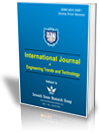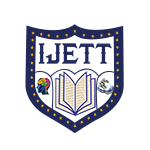Southern Indian Language Braille Image Conversion Systems
Southern Indian Language Braille Image Conversion Systems |
||
 |
 |
|
| © 2025 by IJETT Journal | ||
| Volume-73 Issue-3 |
||
| Year of Publication : 2025 | ||
| Author : G. Gayathri Devi |
||
| DOI : 10.14445/22315381/IJETT-V73I3P130 | ||
How to Cite?
G. Gayathri Devi, "Southern Indian Language Braille Image Conversion Systems," International Journal of Engineering Trends and Technology, vol. 73, no. 3, pp. 436-447, 2025. Crossref, https://doi.org/10.14445/22315381/IJETT-V73I3P130
Abstract
The Southern Indian Language Braille Image Conversion System (SILBCS) is designed to enhance accessibility for visually impaired individuals by converting Braille script into readable text in Southern Indian languages. By focusing on the recognition and interpretation of Braille Image characters specific to regional languages such as Tamil, Telugu, Kannada, and Malayalam, SILBCS offers a tailored solution to address the linguistic diversity prevalent in the area. This system inputs Braille image documents and generates corresponding text files in languages such as Tamil, Telugu, Kannada, and Malayalam. The converted text can be further utilized with speech synthesizers to enable audio output. Through experimentation with datasets containing Braille documents in these languages, the proposed method demonstrated promising performance in accurately converting Braille images into their respective languages, thus facilitating improved access to information and literature for the visually impaired community in Southern India.
Keywords
Braille conversion, Kannada Braille, Malayalam Braille, Southern Indian Language, Tamil Braille, Telugu Braille.
References
[1] Barry Hampshire, Working with Braille: A Study of Braille as a Medium of Communication, The UNESCO Press, 1981.
[Google Scholar] [Publisher Link]
[2] Jan Mennens, “Optical Recognition of Braille Writing,” Proceedings of 2nd International Conference on Document Analysis and Recognition, Tsukuba, Japan, pp. 428-431, 1993.
[CrossRef] [Google Scholar] [Publisher Link]
[3] Jan Mennens, “Optical Recognition of Braille Writing Using Standard Equipment,” IEEE Transactions on Rehabilitation Engineering, vol. 2, no. 4, pp. 207-212, 1994.
[CrossRef] [Google Scholar] [Publisher Link]
[4] Braille, Wikipedia. [Online]. Available: https://en.wikipedia.org/wiki/Braille
[5] Specification 800:2014 Braille Books and Pamphlets, National Library Service for the Blind and Physically Handicapped, Library of Congress, 2014. [Online]. Available: https://www.loc.gov/nls/wp-content/uploads/2019/09/Spec800.11October2014.final_.pdf
[6] Bharati Braille, Wikipedia. [Online]. Available: https://en.wikipedia.org/wiki/Bharati_Braille
[7] Andrean Ignasius et al., “Image Pre-Processing Effect on OCR's Performance for Image Conversion to Braille Unicode,” Procedia Computer Science, vol. 227, pp. 922-931, 2023.
[CrossRef] [Google Scholar] [Publisher Link]
[8] Sana Shokat et al., “Characterization of English Braille Patterns Using Automated Tools and RICA Based Feature Extraction Methods,” Sensors, vol. 22, no. 5, pp. 1-23, 2022.
[CrossRef] [Google Scholar] [Publisher Link]
[9] Falgoon Sen Apu et al., “Text and Voice to Braille Translator for Blind People,” 2021 International Conference on Automation, Control and Mechatronics for Industry 4.0, Rajshahi, Bangladesh, pp. 1-6, 2021.
[CrossRef] [Google Scholar] [Publisher Link]
[10] S. Arockia Kinsely Felix et al., “Enhancing Braille Code Conversion to Text in Multiple Languages,” i-Manager's Journal on Digital Signal Processing, vol. 8, no. 2, pp. 31-36, 2020.
[CrossRef] [Google Scholar] [Publisher Link]
[11] Purvang Patel, V.V. Hanchate, and R.S. Kamathe, “Text To Braille Conversion For Real-Time Teaching (For Grade III Braille),” Natural Volatiles & Essential Oils Journal, vol. 8, no. 6, pp. 3939-3945, 2024.
[Publisher Link]
[12] Ghazanfar Latif et al., “Learning at Your Fingertips: An Innovative IoT-Based AI-Powered Braille Learning System,” Applied System Innovation, vol. 6, no. 5, pp. 1-18, 2023.
[CrossRef] [Google Scholar] [Publisher Link]
[13] Sana Shokat, “Analysis and Evaluation of Braille to Text Conversion Methods,” Mobile Information Systems, vol. 2020, pp. 1-14, 2020.
[CrossRef] [Google Scholar] [Publisher Link]
[14] Changjian Li, and Weiqi Yan, “Braille Recognition Using Deep Learning,” Proceedings of the 4th International Conference on Control and Computer Vision, Macau China, pp. 30-35, 2021.
[CrossRef] [Google Scholar] [Publisher Link]
[15] Robert Englebretson, M. Cay Holbrook, and Simon Fischer-Baum, “A Position Paper on Researching Braille in the Cognitive Sciences: Decentering the Sighted Norm,” Applied Psycholinguistics, vol. 44, no. 3, pp. 400-415, 2023.
[CrossRef] [Google Scholar] [Publisher Link]
[16] J.M. Jennis Oliviya, J. Vijayakumar, and A. Hemalatha, “Conversion of Tamil Braille into Text Information Using the DCNN Technique,” International Journal of All Research Education and Scientific Methods, vol. 11, no. 4, pp. 575-579, 2023.
[Publisher Link]
[17] Ian Herrera, Juan J. Carreras, and Rutilio Nava, “Voice-to-Braille Translation System for Promoting Braille Learning,” International Journal of Engineering and Technology, vol. 16, no. 1, pp. 52-56, 2024.
[Publisher Link]
[18] Urooj Beg, K. Parvathi, and Vinod Jha, “Text Translation of Scanned Hindi Document to Braille via Image Processing,” Indian Journal of Science and Technology, vol. 10, no. 33, pp. 1-8, 2017.
[CrossRef] [Google Scholar] [Publisher Link]
[19] Ganga Gudi, Mallamma V. Reddy, and M. Hanumanthappa, “Efficient Approach for Braille Conversion of Multilingual Text: Strategic Mapping Solutions,” International Journal of Engineering Technology and Management Sciences, vol. 7, no. 4, pp. 653-659, 2023.
[CrossRef] [Publisher Link]
[20] Meneses-Claudio, W. Alvarado-Diaz, and A. Roman-Gonzalez, “Classification System for the Interpretation of the Braille Alphabet through Image Processing,” Advances in Science, Technology and Engineering Systems Journal, vol. 5, no. 1, pp. 403-407, 2020.
[CrossRef] [Google Scholar] [Publisher Link]

